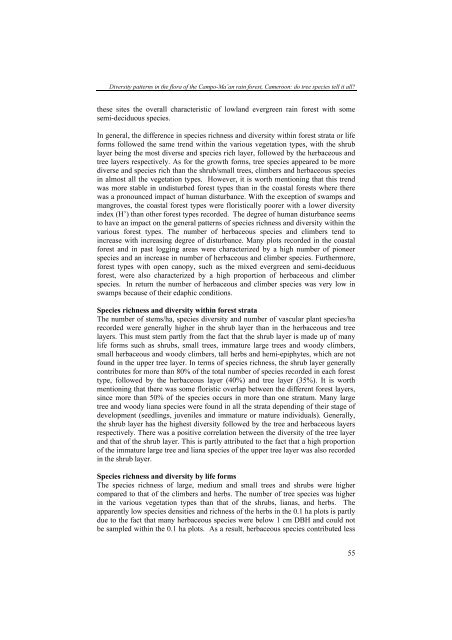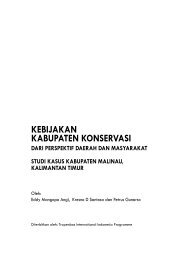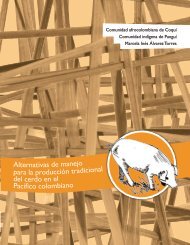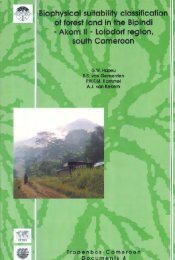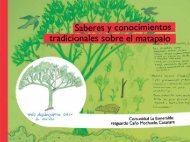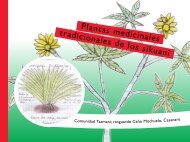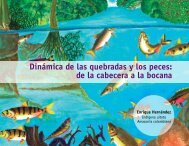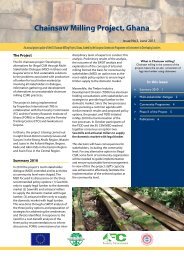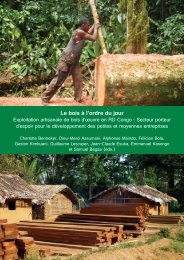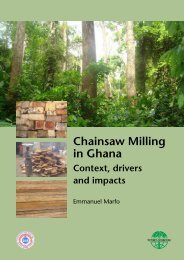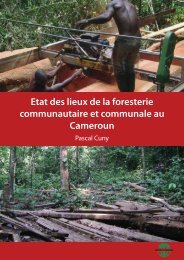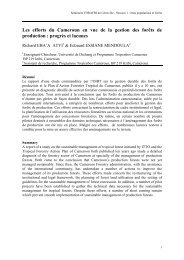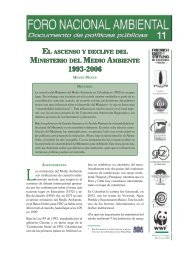Download the publication - Tropenbos International
Download the publication - Tropenbos International
Download the publication - Tropenbos International
Create successful ePaper yourself
Turn your PDF publications into a flip-book with our unique Google optimized e-Paper software.
Diversity patterns in <strong>the</strong> flora of <strong>the</strong> Campo-Ma’an rain forest, Cameroon: do tree species tell it all?<br />
<strong>the</strong>se sites <strong>the</strong> overall characteristic of lowland evergreen rain forest with some<br />
semi-deciduous species.<br />
In general, <strong>the</strong> difference in species richness and diversity within forest strata or life<br />
forms followed <strong>the</strong> same trend within <strong>the</strong> various vegetation types, with <strong>the</strong> shrub<br />
layer being <strong>the</strong> most diverse and species rich layer, followed by <strong>the</strong> herbaceous and<br />
tree layers respectively. As for <strong>the</strong> growth forms, tree species appeared to be more<br />
diverse and species rich than <strong>the</strong> shrub/small trees, climbers and herbaceous species<br />
in almost all <strong>the</strong> vegetation types. However, it is worth mentioning that this trend<br />
was more stable in undisturbed forest types than in <strong>the</strong> coastal forests where <strong>the</strong>re<br />
was a pronounced impact of human disturbance. With <strong>the</strong> exception of swamps and<br />
mangroves, <strong>the</strong> coastal forest types were floristically poorer with a lower diversity<br />
index (H’) than o<strong>the</strong>r forest types recorded. The degree of human disturbance seems<br />
to have an impact on <strong>the</strong> general patterns of species richness and diversity within <strong>the</strong><br />
various forest types. The number of herbaceous species and climbers tend to<br />
increase with increasing degree of disturbance. Many plots recorded in <strong>the</strong> coastal<br />
forest and in past logging areas were characterized by a high number of pioneer<br />
species and an increase in number of herbaceous and climber species. Fur<strong>the</strong>rmore,<br />
forest types with open canopy, such as <strong>the</strong> mixed evergreen and semi-deciduous<br />
forest, were also characterized by a high proportion of herbaceous and climber<br />
species. In return <strong>the</strong> number of herbaceous and climber species was very low in<br />
swamps because of <strong>the</strong>ir edaphic conditions.<br />
Species richness and diversity within forest strata<br />
The number of stems/ha, species diversity and number of vascular plant species/ha<br />
recorded were generally higher in <strong>the</strong> shrub layer than in <strong>the</strong> herbaceous and tree<br />
layers. This must stem partly from <strong>the</strong> fact that <strong>the</strong> shrub layer is made up of many<br />
life forms such as shrubs, small trees, immature large trees and woody climbers,<br />
small herbaceous and woody climbers, tall herbs and hemi-epiphytes, which are not<br />
found in <strong>the</strong> upper tree layer. In terms of species richness, <strong>the</strong> shrub layer generally<br />
contributes for more than 80% of <strong>the</strong> total number of species recorded in each forest<br />
type, followed by <strong>the</strong> herbaceous layer (40%) and tree layer (35%). It is worth<br />
mentioning that <strong>the</strong>re was some floristic overlap between <strong>the</strong> different forest layers,<br />
since more than 50% of <strong>the</strong> species occurs in more than one stratum. Many large<br />
tree and woody liana species were found in all <strong>the</strong> strata depending of <strong>the</strong>ir stage of<br />
development (seedlings, juveniles and immature or mature individuals). Generally,<br />
<strong>the</strong> shrub layer has <strong>the</strong> highest diversity followed by <strong>the</strong> tree and herbaceous layers<br />
respectively. There was a positive correlation between <strong>the</strong> diversity of <strong>the</strong> tree layer<br />
and that of <strong>the</strong> shrub layer. This is partly attributed to <strong>the</strong> fact that a high proportion<br />
of <strong>the</strong> immature large tree and liana species of <strong>the</strong> upper tree layer was also recorded<br />
in <strong>the</strong> shrub layer.<br />
Species richness and diversity by life forms<br />
The species richness of large, medium and small trees and shrubs were higher<br />
compared to that of <strong>the</strong> climbers and herbs. The number of tree species was higher<br />
in <strong>the</strong> various vegetation types than that of <strong>the</strong> shrubs, lianas, and herbs. The<br />
apparently low species densities and richness of <strong>the</strong> herbs in <strong>the</strong> 0.1 ha plots is partly<br />
due to <strong>the</strong> fact that many herbaceous species were below 1 cm DBH and could not<br />
be sampled within <strong>the</strong> 0.1 ha plots. As a result, herbaceous species contributed less<br />
55


